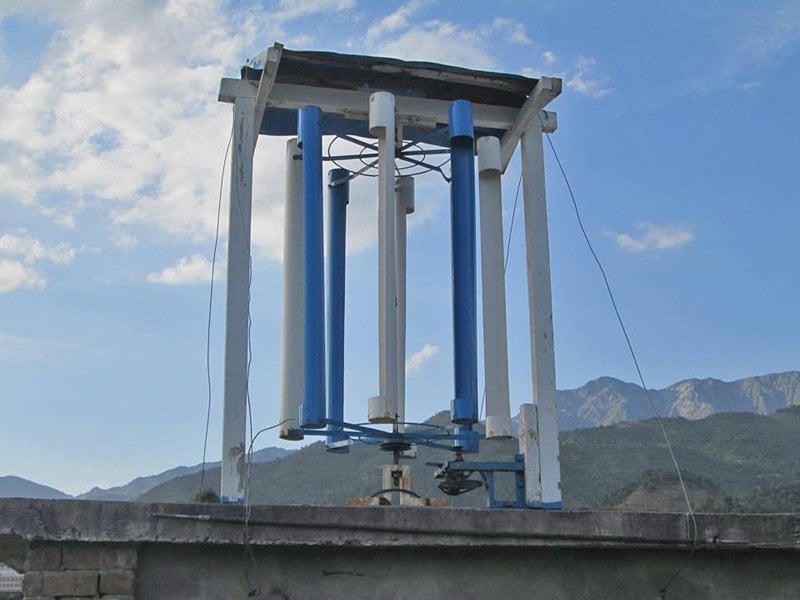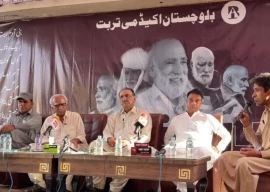
While state-supplied power plays a dark game of hide and seek with consumers, many people have long depended on alternatives suitable to their respective income. Some installed generators or uninterruptible power supply (UPS) while others have turned to greener, long-term cost-effective methods such as solar panels.
And with no end in sight to the energy crisis, people are experimenting with other options. As thermal generation is out of reach for individuals, locals are now trying to produce electricity with the help of wind turbines in hilly areas.
“There has been no suspension of electricity in my house since I installed a wind turbine three years back,” said Fidaullah, an engineer who installed a hybrid system at his home in Lower Dir. The system is supported by both solar and wind energy simultaneously.
The University of Engineering and Technology graduate said his hybrid generates 2,000 watts of electricity at 230 volts; a little over what the Water and Power Development Authority (Wapda) supplies to its consumers (220 volts).
Let there be light
Fidaullah had been living in a hostel and was not used to the hours-long outages which plagued his hometown. It was always difficult for him to study at home during holidays.
“I wanted to do something and generate power with my own resources. The idea clicked when I was working on an assignment in 2010.” Fidaullah drafted a sketch and started collecting the required material.
“I got a wooden door frame and some used PVC pipes. The structure is made from the frame while the PVC pipes are cut into two, so it functions as a rotor and runs the dynamo (an electric generator).”
He recalled his neighbours laughed when they saw what he was doing.
Day and night
For the solar panels, he purchased a Maximum Power Point Tracking (MPPT) system online from the United Kingdom for around £100 (approximately Rs16,600). The MMPT helps manage solar power.
“The solar power system works efficiently once you have both the charge controller and the MPPT.” The enterprising engineer said he uses solar panels during daytime and wind turbines at night.
In Malakand division, Fidaullah added, wind turbines can produce electricity at a much cheaper cost than hydel.
“If the government starts installing wind turbines at Kalpani and Sarlarha mountains, they (government) can generate electricity for Dir and Chitral for free,” he said.
Tajaga, the highest mountain in Dir, has the most favourable conditions for a wind turbine to work, explained Fidaullah.
Leaving WAPDA behind
The UET graduate proudly pointed out he only uses Wapda’s electricity to pump water from wells but all the appliances in his house, including a refrigerator, function on the electricity he produces.
“I am installing one at the house of my in-laws. Initially sceptical, the people in my village are now requesting me to do the same for them,” he said.
If the government takes it seriously, a similar initiative can reduce their electricity burden in these areas, stated Fidaullah.
Published in The Express Tribune, June 9th, 2014.
COMMENTS (21)
Comments are moderated and generally will be posted if they are on-topic and not abusive.
For more information, please see our Comments FAQ

















if thats the design of turbine in the pic, i would say its impressive.
@Mir: Dear, its impossible to use such an independent and individual setup without batteries. either you have to connect such a system to the bulk generation setup like wapda, or use some storage system through converters in case of turbine and through MPPT for solar to charge the batteries. Then use the UPS to convert it back to AC. Its not and easy and cheap setup. Requires high initial investment but later that investment pays off in 10 years may be
Smart engineer! Peshawar's got talent. It sounds like a great business opportunity for him too. Good luck!
Dear engineering student
I would like to have this set up at my place. Email me. Hook me up
Estimated price for 1kVA or 2kVA load?
@Mj: Like hundreds of such grads and their ideas this one will also be suppressed for the gain of corrupt bureaucracy and petroleum companies and that's that
Congrats but better run away from this country or you'd be targeted by Petroleum companies' servant government agencies.
This boy needs to be encouraged.............PTI stand up and do the right thing.
@Chachoo:
While this may not be a new innovation, one should appreciate his effort to do something to solve the energy problem using this ragtag home-made gadget.
@Chachoo: You didn't burst my bubble as it wasn't inflated. Must have missed the last sentence of my comment. Thanks for the reply though. Even if the project is a copy, and it is, that doesn't mean that he should not be encouraged to start a commercial venture, provided that the product is sound.
@Mj:
Great job, I am really proud that you made a difference and that counts.
@Chachoo:
Please leave your semantics alone. What this boy has done is marvelous and more than what many babus are looking at paper. Every watt that is generated is one less what Wapda has to worry about.
Great work. We must learn to stand on our own feet. These creative students should be given special attention from the government to built these instruments.
@Chachoo His setup does not have any batteries mentioned. Load is lower at night because of just using wind therefore he must have to switch a lot of appliances off.
It is applicable only on Sunny and Windy days. But More than 60 percent of Pakistan is not suitable for Wind Energy, so most of the time Wind Harness will not work. Also in order to charge for the night you need a lot of batteries and it is an additional cost on all of the set up.
Dear Chachu: Kindly read,, the engineer uses Solar energy during Day and wind turbine during Night.. even if you dont have a bright sunny day, the wind turbine works .. if you have a little knowledge about Dir district, you will come to know wind blows 365 days :)
@Mj: Sorry to burst your bubble but this project is not a new Innovative project but infact a copy of many projects already available around the world. 2000 Watts is a peak power not a constant or a regular one. It is applicable only on Sunny and Windy days. But More than 60 percent of Pakistan is not suitable for Wind Energy, so most of the time Wind Harness will not work. Also in order to charge for the night you need a lot of batteries and it is an additional cost on all of the set up. Laslty batteries and solar panels have a life of around 10 years and you have to replace them in the stipulated time that will incur additional costs then.
Would someone in govt, wapda, and numerous escos etc lend their eyes and ears?
Very impressive achievement. This lad will go far. Good luck to him.
These folks would be hated by monopolistic companies who deal in UPS, generators and rely on manipulating the short fall..... they should leave for US or Europe and flourish instead of getting wasted..... otherwise they might be at huge risk!
"The University of Engineering and Technology graduate said his hybrid generates 2,000 watts of electricity at 230 volts; a little over what the Water and Power Development Authority (Wapda) supplies to its consumers (220 volts)"
Very impressive if the peak generation is 2000 watts. Comparable solar setup can cost around half a million or more. It'd be interesting to know what the actual generation is under regular, everyday wind conditions.